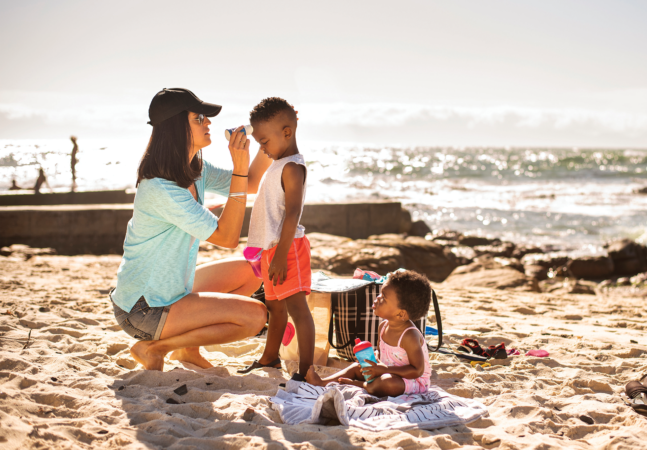Longer days and lighter schedules make summer perfect for relaxing, having fun outdoors and spending time with loved ones. However, more physical activity and time spent in the sun can also translate to increased health and safety risks.
As you and your family enjoy the warmth and sunshine while swimming, biking, grilling, playing on the playground and more this summer, remember these precautions from the experts at the American Heart Association.
Watch for Signs of Heat Stress
On hot summer days, be alert for signs of heat illnesses, such as heat cramps, heat exhaustion or heat stroke. Even when it doesn’t seem extreme, heat and humidity can take a toll. Some signs of heat-related illness include muscle pain, cramps or spasms; heavy sweating; paleness; dizziness; headache; nausea or vomiting; confusion; fainting or unconsciousness; high body temperature (greater than 100 F) with dry skin; and rapid pulse. If you experience any of these symptoms, take a break, drink some water and find shade or air conditioning to cool off. If symptoms worsen or vomiting occurs, seek medical attention.
Stay Hydrated
Staying hydrated is important for optimal body functioning, especially during the hot and humid months. If you plan to spend a lot of time outdoors, frequently consuming water and foods with high water content – melons, lettuce and cucumbers, for example — can help replace the fluids lost via sweat. In addition, be aware of the signs and symptoms of mild dehydration, including a dry or sticky mouth; dry, cool skin; headache; or muscle cramps. More severe cases may include dry, shriveled skin; irritability or confusion; dizziness; rapid heartbeat; rapid breathing; fatigue; and unconsciousness.
Learn CPR
As summertime activities expose people of all ages to risks, it’s important to be trained in CPR — or cardiopulmonary resuscitation – an emergency lifesaving procedure that is performed when the heart stops beating. If performed immediately, it can double or triple a cardiac arrest victim’s chance of survival, according to the American Heart Association. However, only about 40% of people who experience out-of-hospital cardiac arrest receive help before professionals arrive.
Because about 74% of adult and 87.5% of child out-of-hospital cardiac arrests happen in homes, you will likely be trying to save the life of someone you love – a child, spouse, parent or friend – if called upon to perform CPR. Hands-Only CPR is recommended for members of the general public who see someone suddenly collapse. Call 9-1-1, or send someone to do so, then push hard and fast in the center of the person’s chest until medical assistance arrives. Use an AED, if available, following the prompts. Conventional CPR is the next step and involves chest compressions and mouth-to-mouth breathing but should only be used by health care professionals and those trained to perform it correctly.
Protect Skin from the Sun
While it’s easy to get caught up enjoying activities outdoors, remember to take steps to protect your skin from the sun’s damaging rays. Limit your time in the sun, especially during the midday hours when the rays are strongest, and wear sunscreen to help reduce your risk of sunburn, skin cancer and the early onset of wrinkles. Experts recommend sunscreen with an SPF of 30 or higher. Wearing sunglasses, a hat and cool, long-sleeved clothing can further limit exposure when outdoors for long periods of time.
Play Safe
Each year, emergency departments treat more than 200,000 children under the age of 14 for playground-related injuries, according to the Centers for Disease Control and Prevention (CDC). Choose age-appropriate parks and playgrounds for your children and keep precautions like these in mind: teach children to take turns as pushing or roughhousing can result in accidents or injuries, check metal slides before use to prevent burns, remind kids to be careful walking near moving swings and encourage them to go one at a time on slides that are clear of other children. Also be sure to use proper protective gear for other outdoor activities like biking or watersports and have a first-aid kit on-hand, complete with bandages, gauze pads, medical tape, antibiotic ointment, antiseptic wipes or spray and aspirin.
Swim Safely
Whether enjoying the pool, beach, lake or river, bodies of water can be dangerous if appropriate precautions aren’t taken. In fact, drowning is among the top five causes of unintentional injury death in the United States, according to the CDC. Avoid swimming alone, especially in natural bodies of water that aren’t clear and may present strong currents or underwater obstacles, and don’t overestimate your swimming ability. Designating an undistracted “water watcher,” wearing life jackets, ensuring someone in your group knows CPR and avoiding alcohol consumption are also safe practices to keep in mind while swimming.
Be Smart with Fire
Firing up the grill and lighting fireworks are often synonymous with summertime, but open flames pose safety hazards. Never leave a grill unattended, always grill outdoors and keep children and pets away from the grilling area. When it comes to fireworks, keep a safe distance once lit, don’t point fireworks toward anyone’s face or body, never allow young children to play with them, avoid relighting fireworks that do not function properly and keep a bucket of water or fire extinguisher nearby when lighting.
Staying Safe in the Water
Spending time in or around water is one of the joys of summer, but it comes with some risks. Stay safe on and near water with these tips from the American Heart Association:
Learn to Swim – For children ages 1-14, drowning is the second-leading cause of unintentional injury death after motor vehicle crashes, according to the CDC. Basic swimming skills like floating and safely entering and exiting the water can help reduce the risk.
Learn CPR – Accidents can happen in or around water. In the event of a drowning, the American Heart Association recommends rescue breaths along with chest compressions.
Remember Life Jackets – Water wings, floaties and kickboards aren’t substitutes for a U.S. Coast Guard-approved life jacket.
Secure the Pool – Install fencing with self-closing gates at least 4 feet tall to separate the pool from the house and yard.
Clear Out Pool Toys – Make sure children aren’t tempted to play unsupervised by removing toys from the water and storing them in a secure location. (Family Features, American Heart Association, Photos courtesy of Getty Images)




